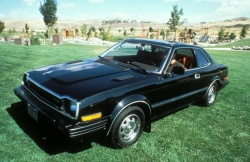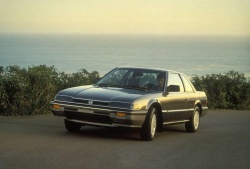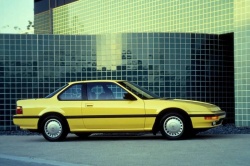 First generation. Click image to enlarge |
By Jeff Burry
Find this vehicle in Autos’s Classified Ads
Photo Gallery:
Honda Prelude, 1979-2001
The first Honda cars to reach North American shores in the early 1970s were anything but exciting, but the Civic and Accord would prove to be reliable and fuel-efficient alternatives to what other manufacturers had to offer – notwithstanding their tendency to rust out in Canadian winters.
Honda offered reliability and fuel efficiency at a time when fuel prices were starting to skyrocket as a result of the OPEC oil embargo in 1973. On this side of the Atlantic, the car-buying public were “warming” quickly towards fuel efficient vehicles. The days of stuffing big motors into small and medium-sized cars were becoming a thing of the past.
It was important for Honda to make a good first impression, and that they did. Throughout the 1970s, the Civic and Accord models could best be described as bland, ordinary “grocery-getter” type vehicles. If North Americans wanted to experience excitement from the folks at Honda, they would have to wait nearly a decade for the Prelude to be unveiled.
The Prelude was Honda’s first attempt to introduce a more refined and “interesting” sports coupe to its lineup, one which consumers might be persuaded into paying a premium dollar for. It debuted in 1979 and shared many components with the Civic and Accord models.
In comparison to later-generation Preludes, the 1979 model was an ugly duckling, complete with a high belt-line and a very Civic-looking front end. The wheel-base for the Prelude was almost three inches shorter than the Accord, giving it a stubby, awkward appearance. Exciting it was not – but as the name “Prelude” suggests, it would become a model in future years that would house some of Honda’s most advanced automotive technology.
Transmission choices for the first generation Prelude were a five-speed manual and a two-speed Hondamatic. This transmission was dropped in 1980 and replaced with a three-speed automatic.
Powering the Prelude was a 1,751-cc version of the Accord’s SOHC (single overhead cam) four-cylinder engine, producing 72 hp and 94 pound-feet of torque. These numbers, while nothing less than abysmal by today’s standard, were comparable with other vehicles in its class.
  Second generation (top); Third generation. Click image to enlarge |
Some critics denounced the interior finishings as well as the “gadgetry” that Honda used, but what the feature pundits had the most disdain for was the amount of space (or lack thereof) that rear passengers had – suggesting the rear cabin of the vehicle would provide passengers with a “claustrophobic-like” touring experience.
The second-generation Prelude, introduced in 1983, was a much more refined model, and possessed little relationship to the Civic and Accord. It was more performance-oriented, longer and wider, and its beltline was lowered, providing the car with that “go fast” appearance, even when parked.
It did, however, share the Accord’s 96-inch wheelbase and was powered by a brand new 1829-cc SOHC 12-valve four cylinder engine producing 110 hp at 5500 rpm. The low belt-line, complete with pop-up headlights and lowered nose, produced a drag coefficient of only 0.36 – promoting it to “best in class.”
Most notably, the suspension involved an innovative upper and lower arm layout (called double-wishbone) providing for a tighter and more responsive driving experience. Midway through the 1985 model year, Honda launched a new 2.0-litre engine in the Prelude Si model featuring fuel injection. The Si was also outfitted with front and aft spoilers, premium sound system and cruise control. This second generation Prelude lasted five model years – from 1983 through to 1987.
To improve upon the next generation Prelude, Honda tweaked its performance and made subtle changes to its appearance. The exterior proportions of the 1988 Prelude were familiar but more purposeful and refined.
Honda also introduced four-wheel steering in 1988. When moving slowly, the rear wheels would turn slightly in the opposite direction to decrease the turning radius, while at higher speeds, they turned in the same direction, to increase high-speed stability, such as in lane changes. These models were badged “4WS” and would cost the consumer an extra $1,300. To this day, it remains the only true mechanical four-wheel steering system offered on a production vehicle. Other manufacturers offered either electronic or hydraulic four-wheel steering systems.







 Follow Autos on Twitter
Follow Autos on Twitter



